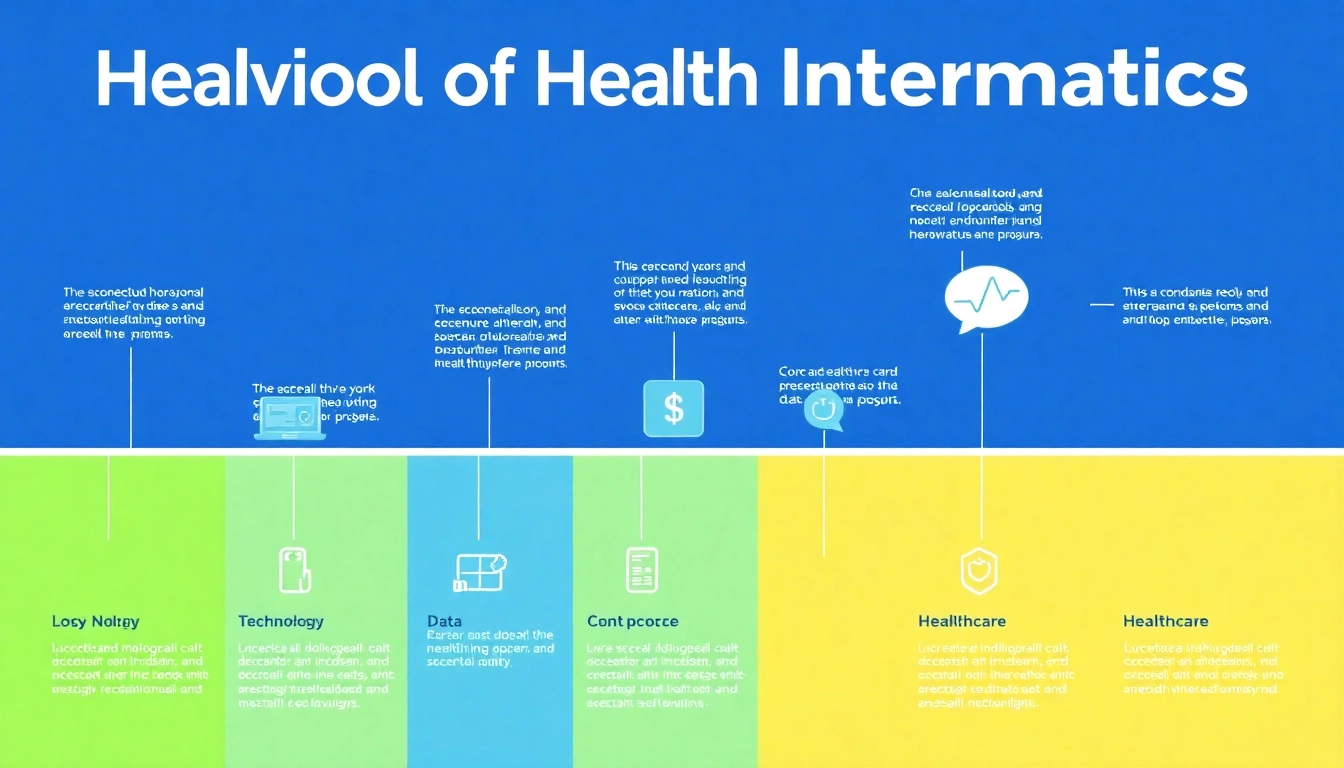Understanding Informatics
What is Informatics?
Informatics is an interdisciplinary field that focuses on the science of how to collect, analyze, interpret, and leverage data in various domains, especially within healthcare. According to the AMIA, informatics is the science of how to use data, information, and knowledge to improve human health and the delivery of healthcare services. The discipline combines elements from computer science, information technology (IT), health sciences, and social sciences to enhance the quality and efficiency of healthcare through technology and processes. This field has seen tremendous growth and transformation over recent years, particularly with the rise of digital health technologies and big data analytics.
A Brief History of Informatics
The roots of informatics can be traced back to the early 20th century when pioneers like Herman Goldstine and John von Neumann began conceptualizing the processes of data handling. However, it wasn’t until the 1960s and 1970s that informatics began to take form as a distinct discipline, heavily influenced by advancements in computer technology and the increasing need for efficient data management in healthcare settings. The advent of the internet further revolutionized the field, allowing vast amounts of information to be shared and accessed more easily than before.
Importance of Informatics in Healthcare
In today’s rapidly evolving healthcare landscape, informatics plays a pivotal role in streamlining processes and improving patient outcomes. By harnessing the power of data, healthcare providers can make informed decisions, enhance patient care, establish more efficient workflows, and ultimately reduce costs. Notably, the integration of informatics into healthcare has made it possible to implement systems such as Electronic Health Records (EHRs), which improve data management and ensure continuity of care. As such, the relevance of informatics is only expected to grow as technologies advance and healthcare systems become more interconnected.
Key Components of Health Informatics
Data Management in Healthcare
Data management is one of the core pillars of health informatics. It involves several key processes including the collection, storage, analysis, and dissemination of health data. Efficient data management practices are essential for ensuring patient safety, improving clinical outcomes, and enabling healthcare organizations to operate effectively.
Organizations must implement robust data governance frameworks that define data standards, ensure data quality, and comply with regulations like the Health Insurance Portability and Accountability Act (HIPAA). Data analytics tools and methodologies, such as predictive analytics and big data frameworks, can provide insights that drive decision-making and strategic planning.
Technology in Health Informatics
Technology serves as the backbone of health informatics. From simple online databases to complex health information exchange systems, the technological landscape in healthcare is dynamic and continuously evolving. Key technologies in health informatics include:
- Electronic Health Records (EHRs): Digital versions of patients’ paper charts, EHRs are real-time, patient-centered records that make information available instantly and securely to authorized users.
- Clinical Decision Support Systems (CDSS): These systems provide healthcare professionals with knowledge and patient-specific information to enhance their decision-making capabilities.
- Telemedicine: The use of telecommunications technology to provide medical information and services, telemedicine facilitates remote consultations and enhances access to care.
Clinical Decision Support Systems
CDSS are integral in modern healthcare settings, offering clinical staff healthcare recommendations based on a user’s data. They enhance the quality of care by effectively synthesizing a patient’s data, medical history, and existing research to provide actionable insights. CDSS can alert clinicians about potential errors, facilitate adherence to clinical guidelines, and promote best practices, leading to improved patient safety and outcomes.
Applications of Informatics
Patient Records and EHRs
The advent of EHRs has been one of the most significant advancements in health informatics, with applications spanning clinical management, research, and administrative processes. These electronic platforms enable providers to document patient interactions, track health outcomes, and facilitate communication across disparate departments and facilities. Moreover, EHRs can enhance care coordination by providing a comprehensive view of patient data, thus allowing for better-informed clinical decisions.
Telemedicine and Remote Care
Telemedicine is rapidly transforming the way healthcare is delivered by eliminating geographic barriers and improving access to care, especially in rural or underserved regions. With the incorporation of informatics, telehealth platforms allow for virtual consultations, remote patient monitoring, and follow-up care without the need for patients to travel to healthcare facilities. This evolution of service delivery not only increases convenience for patients but also expands the reach of healthcare services.
Health Information Exchange (HIE)
HIE facilitates the seamless sharing of health information across different healthcare systems, enhancing the continuity of care. By integrating multiple data sources, HIE enables providers to access comprehensive patient information, leading to better-informed and timely clinical decisions. Effective HIE initiatives can dramatically improve care coordination, reduce duplicate testing, and have a positive impact on patient outcomes by ensuring critical data is easily accessible whenever needed.
Challenges and Solutions
Data Security in Healthcare
Data security represents one of the most pressing challenges facing the field of health informatics. Healthcare organizations must protect sensitive patient information from breaches and unauthorized access while complying with stringent regulations. Implementing robust cybersecurity strategies, conducting regular assessments, and fostering a culture of security awareness among staff are essential steps to mitigate risks. Utilizing multi-factor authentication and advanced encryption protocols can also bolster security measures, ensuring that patient data is safeguarded against potential threats.
Integration of New Technologies
The rapid pace of technological advancement poses both opportunities and challenges for healthcare providers seeking to integrate new informatics tools. Organizations often encounter difficulties in adopting new systems that can seamlessly integrate with their existing infrastructure. Adopting best practices such as phased rollouts, organizational change management, and engaging stakeholders during the implementation process can alleviate these integration hurdles. Training programs can equip healthcare personnel with necessary skills and instill confidence in using new technologies effectively.
User Training and Adoption
Even the most sophisticated informatics systems can falter without proper training for end-users. Resistance to new technologies is a common issue, often stemming from a lack of familiarity or perceived complexity. To overcome this challenge, healthcare organizations should prioritize comprehensive training programs, enabling staff to understand the benefits of informatics solutions thoroughly. Involving users early in the development and deployment stages can also foster a sense of ownership and enhance adoption rates.
The Future of Health Informatics
Trends Shaping Informatics
The future of health informatics promises to bring about transformative changes driven by several trends, including an increased focus on personalized medicine, enhanced patient engagement, and the adoption of value-based care models. Technologies such as cloud computing, the Internet of Things (IoT), and blockchain are set to redefine data management and accessibility within healthcare, amplifying the potential for better care delivery and patient outcomes.
Impact of AI and Machine Learning
Artificial intelligence (AI) and machine learning (ML) are transforming health informatics by enabling predictive analytics and automating routine tasks. These technologies allow for the identification of patterns within vast datasets, enhancing patient care by predicting health risks and personalizing treatment strategies. AI-driven tools can significantly reduce the administrative burden on healthcare providers while improving accuracy in patient assessments and decision-making processes.
Improving Patient Outcomes through Informatics Strategies
Ultimately, the goal of health informatics is to improve patient outcomes through strategic applications of technology and data. By optimizing workflows, enhancing communication, and leveraging data analytics, health informatics can facilitate proactive healthcare measures. Continuous evaluation and feedback mechanisms, combined with adherence to best practices, will ensure that healthcare organizations can effectively monitor, assess, and improve the impact of informatics on patient care.
As we continue to explore the depths of informatics in healthcare, platforms such as informaticsview.com provide valuable insights into the evolving methods and technologies that contribute to the future of healthcare efficiency and effectiveness.



